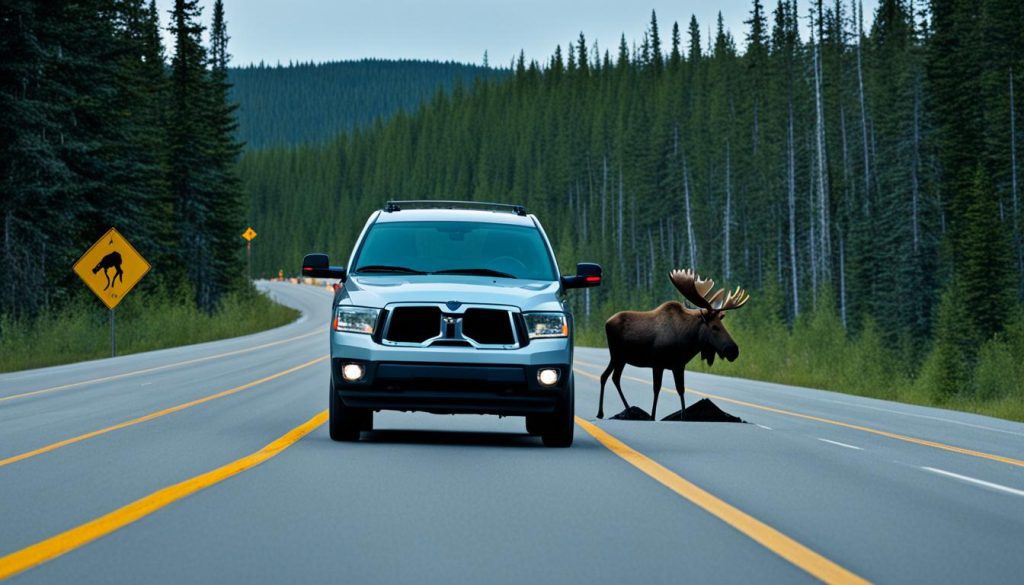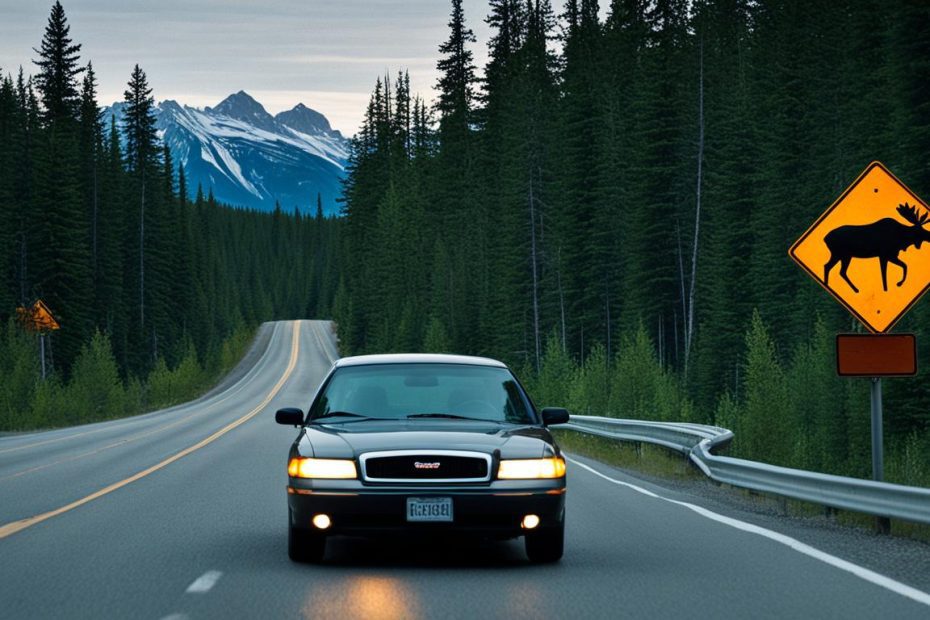Wildlife-vehicle collisions (WVCs) in Canada cost $200 million every year. They cause many problems. Every year, 17 people die, 2,003 get hurt, and 37,754 cars have damage. Over 30 species that are endangered or at risk are affected too. For Canadian drivers, avoiding these accidents is very important for safety when driving through wild areas.
Key Takeaways
- Wildlife-vehicle collisions pose a serious risk to both people and animals in Canada, resulting in substantial costs and ecological damage.
- Drivers must be vigilant in scanning the roadway, reducing speed in designated areas, and utilizing safety features to avoid collisions with wildlife.
- Innovative solutions, such as wildlife crossings and animal detection systems, are being implemented to enhance road safety and protect Canada’s diverse wildlife populations.
- Collaboration between the public and transportation authorities is crucial for reporting incidents and supporting mitigation efforts.
- A comprehensive approach, including habitat management, public education, and technological advancements, is necessary to effectively protect cars from wildlife on Canadian roads.
Understanding the Risks of Wildlife Collisions
Wildlife-vehicle collisions are a serious problem across Canada. In one year, they caused 17 deaths and over 2,000 injuries. There were also 37,754 reports of property damage. These numbers, however, are likely higher than reported.
Statistics on Wildlife-Vehicle Collisions in Canada
The impact of these collisions is considerable. Thousands of people are affected. Each year, millions of dollars are spent dealing with the aftermath. Knowing the scale of this issue helps create ways to keep people and animals safe.
Impact on Wildlife Populations
Wildlife-vehicle collisions don’t just harm people, they also threaten animals. They are especially dangerous for over 30 species in Canada. It’s essential to protect these animals and the places they live.
Costs Associated with Wildlife Collisions
Dealing with wildlife-vehicle collisions costs Canada a lot – up to $200 million every year. This money goes to doctors, fixing cars, and more. Finding ways to prevent these accidents is key for safety and saving money.
Watch for the Signs
In Canada, being alert to wildlife warning signs is extremely important. They warn us about animals that might be nearby. This helps drivers stay ready to avoid hitting them. Understanding these signs makes the roads safer for everyone.
Interpreting Wildlife Warning Signs
Wildlife crossing signs are the most common way to prevent car crashes with animals. They tell drivers that animals could be crossing the road. These signs come in many types, like caution signs, enhanced caution signs, seasonal signs, and more.
The yellow diamond signs with animals are well-known. They tell us to be careful and look out for wildlife. Some signs go further, using flashing lights or special materials to make us notice them. Seasonal signs show us when animals are more active, like when they’re migrating or breeding.
High-Risk Areas for Wildlife Encounters
Knowing about warning signs is one thing, but drivers should also watch for specific areas where they might see animals. These places are close to nature, like forests and wetlands. Animals come onto the road looking for food, water, or new homes.
Being alert in these risky areas and driving slower can prevent accidents with animals. It’s critical to follow the wildlife warning signs and be cautious. This keeps drivers and local wildlife safe on Canada’s roads.
Reduce Speed in Designated Areas
Speed limits are being cut in places where lots of animals roam. This helps drivers react faster and keeps animals safer from car accidents in Canada. Road agencies often lower speed limits, especially in parks, to reduce wildlife crashes. This happens where roads were built for faster travel but now have more accidents with animals.
Benefits of Slower Speeds
Driving slower has many pluses in areas where animals cross. It gives drivers more time to see and avoid animals on the road. This takes down the risk of crashing. Slower speeds also mean less harm if a crash does happen. This helps keep both people in cars and wildlife safer.
Driver Behavior and Speed Compliance
Making sure drivers follow these lower speed limits is key. Public education about these rules is important. It helps everyone understand why these limits are crucial. Police enforcing these rules also plays a big part. It keeps people driving safely, which is better for the animals and us.
Drive Defensively and Stay Alert
Driving defensively is key on Canadian roads where wildlife and people share the space. It is crucial to stay on high alert and look out for animals. By anticipating animal behavior and scanning the roadways for wildlife, you sharply decrease the chance of hitting an animal.
Scanning the Roadway for Wildlife
Keep on the lookout for wildlife by watching the road, the sides, and beyond. Watch for eyes shining in the dark and lights from other cars that may mean an animal is nearby. Be ready to act fast if one shows up.
Anticipating Animal Behavior
Learning about animal behavior on Canadian roads helps you forecast what they might do next. For instance, seeing one deer might mean more are around. Be extra careful near forests or rivers where you might find moose and bears. They can be looking for food or salt.
Protect Car from Wildlife Canada
It’s important to keep your car in great shape, especially in wildlife areas. You can lower the chance of hitting animals by keeping your vehicle visible and making sure the lights work well. Adding safety features also helps protect against wildlife.
Maintaining Your Vehicle’s Visibility
Wildlife accidents can be reduced if you regularly check your car’s lights. Make sure your headlights, signal lights, and taillights are clean and function well. Also, clean your windshield and align your headlights properly. This helps other drivers and lets you see animals better at night.
Using Vehicle Lighting Effectively
Having good vehicle lights is crucial for spotting animals. It’s smart to check your headlight lenses often, especially in the spring and fall. If they are cloudy or scratched, you might not see well. You might want to switch to LED headlights since they light better and last longer.
Safety Features for Wildlife Encounters
Hitting a large animal can be dangerous but adding safety gear can help. Strong bumpers or guards can protect your car if you hit an animal. Also, you could add special paint or treatments to make your car less interesting to wildlife.
Taking care of your vehicle, focusing on its lights, and using right safety gear can keep you safe from wildlife in Canada.
Wildlife Crossing Structures
Canada’s national parks are now safer for both visitors and wildlife. Parks Canada has introduced special crossings. These let animals pass over or under roads safely.
Overpasses and Underpasses
Wildlife overpasses are bridges that let animals walk over roads. They are key for animal safety. These bridges are especially helpful for big animals like bears and moose. But, smaller animals and birds can use them too.
Besides these overpasses, eco-passages have been built. These are tunnels for wildlife to cross under roads. Eco-passages keep animals away from cars, making their journey safer.
Exclusion Fencing and Eco-Passages
Alongside roads, special exclusion fencing has been put up. It helps direct animals to cross safely at overpasses or underpasses. This keeps them away from dangerous road crossings.
Wildlife overpasses, eco-passages, and exclusion fencing work together. They make a network for animals to travel without danger. This effort by Parks Canada and its partners supports safe journeys for wildlife and people.

Emerging Technologies
Efforts are under way to lessen wildlife-vehicle crashes, and new solutions are coming up. The use of animal detection systems for roads is one standout. These systems spot animals with sensors and cameras. Then they warn drivers by activating signals.
Animal Detection Systems
These systems detect where animals are and inform drivers with signs or lights. They work in real-time, warning drivers about animals on the road. This helps reduce crashes by making drivers slow down and be more aware.
Solar-Powered Warning Systems
Solar-powered wildlife warning tech is another new idea. It features solar panels in the road. These panels can notice animals and warn drivers without needing outside power. This makes them great for stopping crashes in a way that’s both green and smart.
Roadside Habitat Management
Reducing wildlife-vehicle crashes on Canadian roads is key. Roadside habitat management is a vital tactic. Parks Canada and others work together. They aim to guide wildlife away from roads. This is done by managing plants and offering other salt spots.
Vegetation Control
Keeping roadside plants in check is important. The idea is to make roadsides less appealing to wildlife. This cuts down on animals coming onto the road. They do this by cutting, trimming, and removing some plants.
Salt Lick Alternatives
Installing other salt sources is also a big step. Animals like deer and moose are attracted to road salt. To reduce this danger, salt licks away from roads are put in place. This helps keep animals away from the danger of traffic.
Improving the roadside helps everyone. It makes the roads safer for both people and animals. This part of the plan is very important. It works to lower the risk of animals being hit by cars.
Public Education and Awareness Campaigns
Helping Canadians understand the dangers of wildlife on roads is key to cutting down wildlife-vehicle collisions. This means teaching the public through education on wildlife collision prevention. These lessons might be shared in awareness campaigns for driving safely in animal habitats when risks are highest.
A good example is the campaign from the Ministry of Transportation. They hand out brochures at parks and rest areas. These brochures offer advice like how to spot wildlife dangers and what speed to drive in these areas. They also talk about what to do if you can’t avoid hitting an animal.
Partnerships with wildlife groups help in hosting talks and workshops too. These events are about caring for nature and driving safely where animals live. They aim to make motorists more aware and careful in these areas. This way, they hope to protect both people and wildlife.
In addition, some governments use ads to warn about wildlife-vehicle collisions. These ads are on TV, the radio, and online. They’re meant to grab more people’s attention and make them understand the issue. This way, many more Canadians learn how to drive more safely when wildlife is around.
Together, these strategies are making a difference. By focusing on public education on wildlife collision prevention and awareness campaigns for driving safely in animal habitats, efforts are shifting driving culture. Everyone, from drivers to conservationists, is joining forces against these collisions. Such a united front is crucial to protecting lives and the environment alike.
Collaborating with Transportation Authorities
Parks Canada is teaming up with others nationwide. They aim to make roads in protected areas safer for animals and people. This work involves joining with transportation officials to put in place steps that lower wildlife-vehicle collisions.
Reporting Wildlife Collisions
One crucial piece is letting transportation authorities know about crashes. By sharing details like where and how often these accidents happen, officials can focus on the most dangerous spots. This helps them choose the best solutions to keep people and wildlife safe.
Supporting Mitigation Efforts
Parks Canada also helps transport groups take action. They give advice on how to build and where to place things like wildlife crossings. Plus, they push for fences and passages that help animals cross the road without danger.
Together, these efforts aim for roads that are safer for everyone. Transportation teams and those working to protect nature team up. They strive to find ways that save both animal and human lives on Canadian streets.

Conclusion
Protecting cars on Canadian roads from wildlife needs many actions. It includes knowing the dangers and how often they happen, driving in ways that help prevent problems, and using new tech. This mix of stuff makes driving safer and helps wildlife too.
Drivers can be safer by watching carefully, slow down when needed, and using cars to see better. This makes it less likely to have a bad surprise with an animal. Also, special crossings for animals, systems that detect them, and looking after their homes better, keep animals away from roads. This makes the roads safer for everyone.
Keeping cars safe from wildlife needs everyone to work together. This means the people who plan roads, wildlife experts, and drivers. By learning what to do, telling about accidents, and helping with ways to prevent them, we can all help. Together, we can lower the danger and protect our nature.
